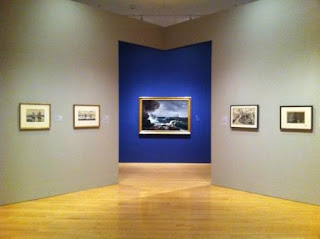Post by: Mary Case, Inventory Consultant
Organizational Coach, Qm2:
Quality Management to a
Higher Power
Joining the WCMFA Collections Inventory Project, afforded me
the privileged opportunity that a skilled outsider always receives when offered
a temporary spot on a functioning team.
This team -- Jennifer Chapman Smith, Lauren Ippolito, and Linda Dodson
-- and joined later by
Kay Palmateer -- managed to uncover and
address with energy and curiosity every challenge of a museum collections
inventory.
First, the collections areas needed to be outfitted for the
work. Out with the old boxes, periodicals,
unusable castoffs, and accumulations that occur in shared workspaces over
decades. Yes, they did unearth a desiccated snake way back in the corner. Yikes!
Careful with the measurements and allocations of potential
spaces for specific work and specific collections to be moved into freshly
organized spaces. More care lavished on
cleaning floors, walls, crevices, pipes. Every space, cabinet, and shelf were
freshly numbered and labeled. Hygrothermographs ready.
Museum collections have two parts: the object and the information about it. So, from the start, the team thought deeply
about how to migrate information from an inadequate legacy computer program and
how to integrate the standing files. A
skilled volunteer – Judy Wheeler --
scrubbed the data and we were launched into the world of PastPerfect.
What is the role of a consultant in this sort of
exercise? Listening carefully and asking
questions. Sometimes more than
once. Connecting staff and volunteers
with resources. Present different ways
of thinking about things, from the sidelines.
Watching as the work proceeded, in spite of all the normal and unusual
distractions of life and the nonprofit workplace. Coaching.
When asked what they felt what my role in the inventory process is and how I have assisted in the process, Jennifer and Lauren responded:
Mary Case brings a deep understanding of museum practices and
procedures as well as a perceptive insight into people and teams. All of this
knowledge combined has made Mary an invaluable resource for the WCMFA’s
collection inventory project. As a consultant she brings with her a fresh
perspective and new ideas. She is especially good at facilitating discussions
and asking the questions that create deeper thinking about the WCMFA’s
collection and how we use it to enrich our visitors’ experience.






